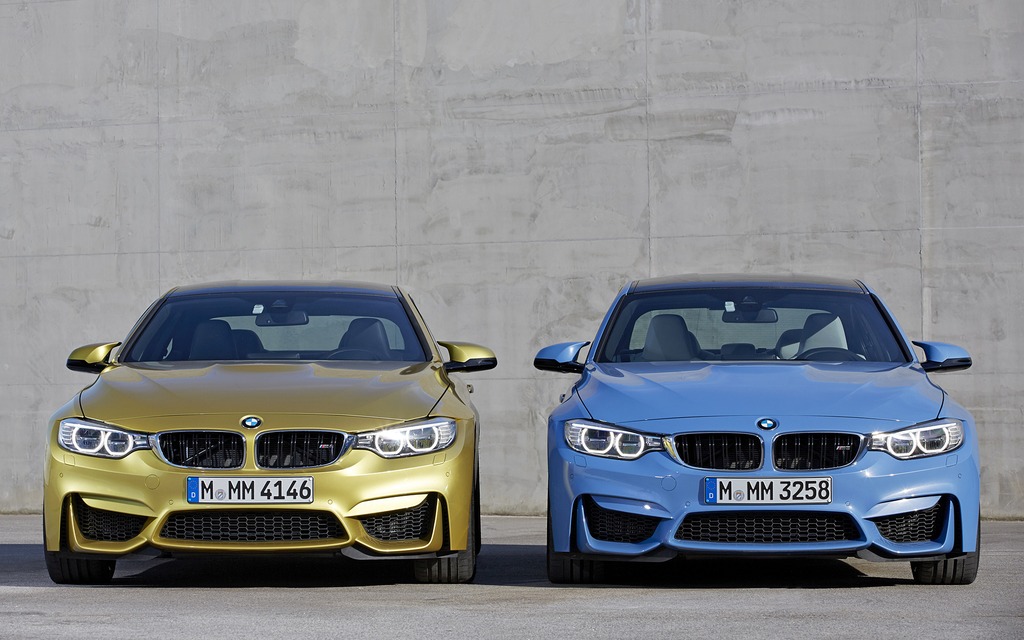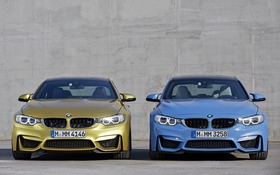2015 BMW M3/M4 - Heads For Style, Tails For Space

| Strong points |
|
|---|---|
| Weak points |
|
To think that BMW developed the first M3 in 1985 as a race car. In 1987, its first year of competition, this vehicle propelled Italy’s Roberto Ravaglia to pole position in the World Touring Car Championship. And that’s not all. The M3 also finished first in Europe, Britain, Australia and Germany (in the well-known DTM series) and earned the top spot at the 24 Hours of Spa and the Tour de Corse, the French round of the World Rally Championship. Humble beginnings. Or not!
To qualify the vehicle for certification, BMW had to produce 5,000 units of the first M3, whose code name was E30. In the end, the automaker made nearly 17,000 units of this angular coupe, which was powered first by a 2.3-litre four-cylinder and then by a 2.5-litre. Today, these originals have become true cult classics.
The second generation, code name E36, is equally idolized. Its inline-six engine started with 3.0 litres of displacement but was increased to 3.2 litres. Between 1992 and 1999, some 71,000 units were produced as coupes, sedans and convertibles.
Dubbed the E46, the third generation was equipped with a 3.2-litre engine. More than 85,000 units were built during its lifetime, which concluded in 2006. The fourth gen shook things up by featuring a 4.0-litre naturally aspirated V8 with a penchant for high revs. Delivering 414 horsepower at 8,300 rpm and 300 lbs.-ft. of torque at 3,900 rpm, this engine was on par with race car mills.
A return to its roots and much more
The M3 was completely revamped for 2015. This fifth generation model brings back one of the inline-six mills that brought fame to the BMW name. However, the German automaker has separated the fraternal triplets that made up the M3 series for the last 20+ years. From now on, the M3 badge applies only to the sedan, while the convertible and coupe fall under the M4 name. These two share the same architecture and drivetrain as the sedan, but don’t bother with the rear doors.
The M3 and M4 are longer and wider than their predecessors and yet they’ve shed about 80 kg thanks to lighter materials. The front fenders, hood and most suspension parts are now made out of aluminum. Since the drive shaft is now made from carbon fibre reinforced plastic (CFRP), it’s more rigid and 40% lighter. Look under the hood and right away you’ll spot the boomerang-shaped reinforcement bar made of the same material. It weighs a mere 1.5 kg.
Using carbon fibre for the roof has trimmed 5 kg off the sedan and 6 kg off the coupe. It also lowers the vehicles’ centres of gravity. Both of these vehicles already ride low, which adds to their distinctive looks. This is especially true for the M4 coupe, as the M3 sedan naturally looks more serious with its higher and more squarish roofline. BMW claims that both vehicles have a drag coefficient of 0.34, but the coupe is slightly more aerodynamic overall.
The M3’s rear seats are more easily accessible and comfortable for your average adult thanks to the extra 40 mm of clearance gained from the higher roofline in back. Its trunk is also larger and more practical, with 480 litres of volume. The coupe’s trunk isn’t bad, though, with 435 litres. The 60/40 rear seat back folds down in two parts, but there’s no pass-through for skis or snowboards.
Twin turbos to the rescue
The all-new 3.0-litre inline-six is turbocharged for the first time in an M3 and obviously for an M4. Its pair of turbochargers plug into an air cooling system that, like the turbochargers, is liquid-cooled. They don’t kid around with this sort of thing in Munich. After all, if you want to be able to push the M3 or M4 to the limit on the track (or in a race), they have to be pretty robust.
These vehicles certainly have the muscle they need with 425 horsepower at 5,500 rpm and a maximum torque of 406 lbs.-ft. at just 1,850 rpm. That’s enough to spirit the M4 coupe from 0 to 100 km/h in 4.65 seconds and blaze it past the quarter-mile mark in 12.79 seconds with a top speed of 185.6 km/h. That’s with the factory-standard six-speed manual transmission that happens to be more compact and 12 kg lighter than the previous one.
The M3 sedan reached 100 km/h in 4.62 seconds and completed the quarter-mile in 12.53 seconds at 190.9 km/h, despite the fact that it weighs 30 kg more (of which 25 are due to the optional DCT transmission with an automated dual clutch). It could easily shave off a few tenths of a second if its launch control mode did a better job of controlling wheelspin. It really allows for too much spinning, even if you reduce the launch rpm to 2,500 rpm. The launch control gets going more easily than before, but it deactivated itself almost immediately during our trials, apparently because of overheated clutches. We would have needed to let them cool off in order to use it effectively.
The M3 and M4 do equally well on the 80 to 120 km/h sprint (3.15 vs. 3.2 seconds) and on braking distance from 100 km/h (35.1 vs. 36 metres). The M4 coupe would most definitely have been a contender in the sports car match-up for the 2015 Guide de l’auto, along with the Corvette Stingray, Jaguar F-Type Coupé R and Porsche 911 Carrera 4 S. Too bad it arrived too late.
The options game
Like the Jag and the Porsche, the M3/M4 duo can be equipped with carbon-ceramic brakes for an extra cost of $8,500. Our test vehicles were already laden with oodles of options and consequently their prices were sky high. We genuinely appreciated the Surround view, rear view camera, parking-assist radars, excellent heads up display with real-time speed limit alerts, the numerous safety systems—heck, why not!—and the terrific headlamps.
Opinions were divided on the metallic paint ($895) on our test cars, which were Yas Marina Blue (after the Abu Dhabi Grand Prix circuit) for the M3 and Austin Yellow for the M4 coupe. You either love ‘em or hate ‘em, depending on your age and gender. Good luck guessing who liked what!
Made-to-measure personality and handling
On the road, the M3 and M4 are very much alike, which comes as no surprise. Both offer a very firm ride and their ultra-low profile tires are equally up to rolling over cracks and bumps, despite the fact that the M4’s springs and calibration are supposed to be firmer. The sexy sport seats are superbly sculpted, though some people find the seat bottom uncomfortable for their backside after a few hours of driving. Not exactly a scientific conclusion!
The manual gearbox is quick and straightforward, while the dual-disc clutch is superbly progressive and not too heavy. Both are house specialties. Heel-toe fans will love the excellent pedals, but you have to engage Sport Plus mode to get the most out of this technique. Otherwise, the computer tries to adjust engine revs with Rev-Match downshifts, initially a Nissan invention for its Z model, but now found in the Porsche 911 and Corvette Stingray. Oh how we wish that BMW would let us deactivate it at will in any driving mode.
We liked, however, the M1 and M2 buttons on the left side of the steering wheel that allow the driver to modify the personality and handling of the sister cars. With the M1 button, I selected Sport Plus mode for the steering, suspension, DCT gearbox (in the M3) and engine, which at the same time opens the valves on the exhaust and releases a loud, husky sound. It was a bit extreme for a highway drive, but nonetheless fun in small doses.
With the M2 button, I selected the Sport modes, which are less extreme, but kept the stability control in MDM mode on the highway for both cars. There’s a button to deactivate it on the track and another that lets you alter the steering weight for the electric power steering. It is decidedly too heavy for the highway in Sport Plus mode and too light in Comfort mode. We’ll stick to Sport mode, thank you very much.
While we wait for what’s next
On the highway, it would be crazy to push the M3 and M4 to the max on corners, given the serious grip and unwavering confidence of the Michelin Pilot Super Sport tires. We’ll have to drive these cars on the track to find out more. For the time being, they glide over the road like race cars that haven’t had the chance to mellow. These two vehicles are bundles of muscles and nerves driving among a herd of docile compacts that they could devour in a single bite. As an added bonus, we even obtained a fuel consumption rate of 7.9 L/100 km on a pleasant Sunday drive in the M3.
More power, more personality, improved fuel economy and less emissions. The M3 and M4 offer the most perfect blend of performance, handling and civility available today. The M3 Sedan is even practical. All that’s left is to bring it out to the track with a few of its rivals so that we can write the end to this story.











